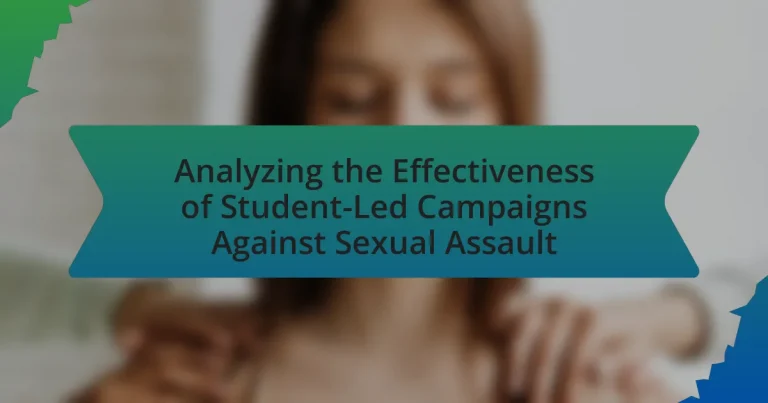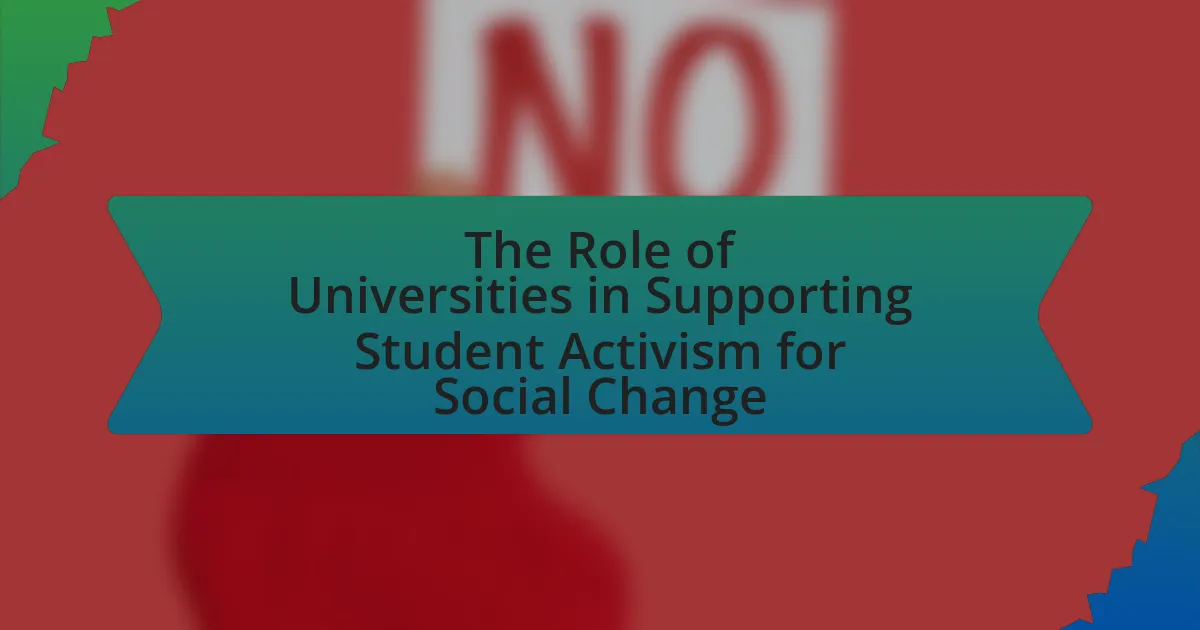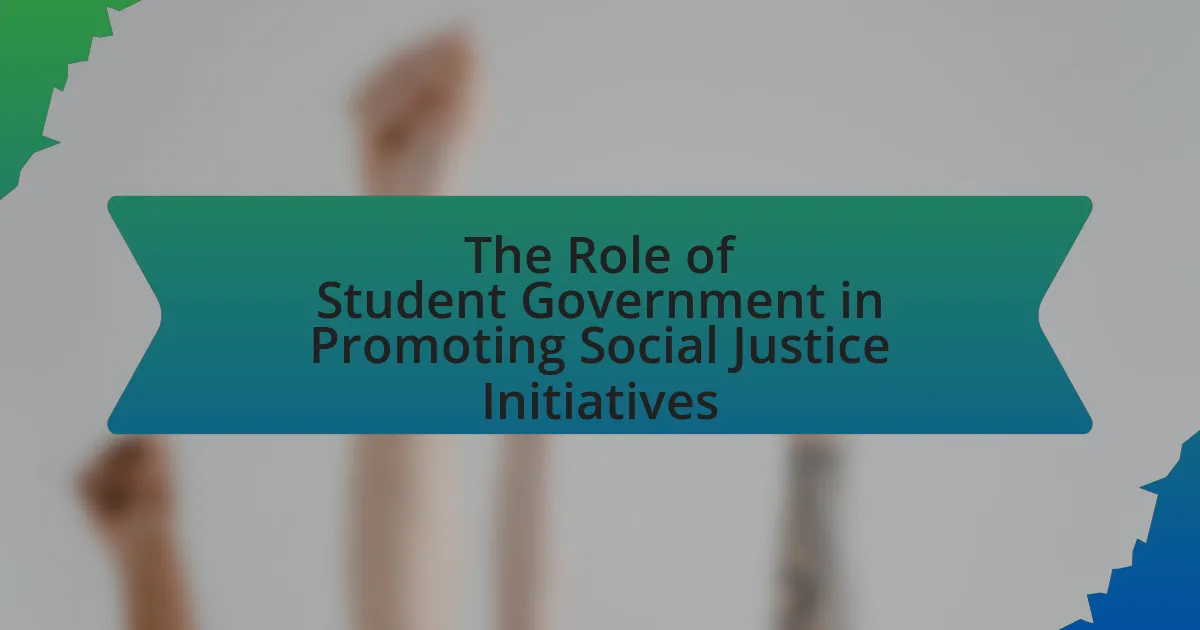Student-led campaigns against sexual assault are initiatives organized by students to raise awareness, educate peers, and advocate for policy changes regarding sexual violence on campuses. These campaigns employ various strategies, including workshops, rallies, and social media outreach, to foster a culture of consent and support for survivors. The article analyzes the effectiveness of these campaigns by examining their operational strategies, key stakeholders, impact on campus culture and policies, and the metrics used to measure success. It also addresses the challenges faced by these initiatives and highlights best practices for future campaigns, emphasizing the importance of grassroots mobilization and community engagement in combating sexual violence.

What are Student-Led Campaigns Against Sexual Assault?
Student-led campaigns against sexual assault are initiatives organized by students to raise awareness, educate peers, and advocate for policy changes regarding sexual violence on campuses. These campaigns often include activities such as workshops, rallies, and social media outreach aimed at fostering a culture of consent and support for survivors. Research indicates that such campaigns can significantly impact attitudes and behaviors related to sexual assault, as evidenced by a study published in the Journal of Interpersonal Violence, which found that student-led initiatives increased awareness and reduced victim-blaming attitudes among participants.
How do these campaigns typically operate?
Student-led campaigns against sexual assault typically operate through awareness-raising activities, educational workshops, and community engagement initiatives. These campaigns often involve students organizing events such as rallies, workshops, and discussions to inform peers about consent, bystander intervention, and available resources. Research indicates that such campaigns can significantly increase awareness and change attitudes towards sexual assault, as evidenced by a study published in the Journal of Interpersonal Violence, which found that student-led initiatives led to a 30% increase in knowledge about consent among participants.
What strategies do student-led campaigns employ to raise awareness?
Student-led campaigns employ strategies such as social media outreach, educational workshops, and community events to raise awareness about sexual assault. Social media platforms enable students to reach a broad audience quickly, facilitating the dissemination of information and personal stories that resonate with peers. Educational workshops provide critical information on consent and resources available for survivors, fostering a more informed community. Community events, such as rallies or informational booths, engage the public directly, creating a visible presence that encourages dialogue and support. These strategies have been shown to effectively increase awareness and promote discussions around sexual assault, as evidenced by campaigns like “It’s On Us,” which mobilized students nationwide to take action against sexual violence.
Who are the key stakeholders involved in these campaigns?
The key stakeholders involved in student-led campaigns against sexual assault include students, educational institutions, advocacy organizations, and local law enforcement. Students are the primary drivers of these campaigns, raising awareness and promoting change within their communities. Educational institutions, such as universities and colleges, play a crucial role by providing resources, support, and platforms for these initiatives. Advocacy organizations, like sexual assault prevention groups, offer expertise, training, and collaboration opportunities to enhance the effectiveness of campaigns. Local law enforcement agencies are also stakeholders, as they can provide guidance on legal aspects and support in addressing incidents of sexual assault. These stakeholders collectively contribute to the campaign’s goals of prevention, education, and support for survivors.
Why are student-led campaigns important in addressing sexual assault?
Student-led campaigns are important in addressing sexual assault because they empower peers to engage in prevention and awareness efforts directly within their communities. These campaigns foster a sense of ownership and responsibility among students, leading to increased participation and support for initiatives aimed at changing campus culture. Research indicates that peer-led interventions can significantly reduce incidents of sexual violence; for instance, a study published in the Journal of Interpersonal Violence found that student-led programs increased knowledge about consent and reporting mechanisms by 30%. By utilizing relatable messaging and fostering open dialogue, student-led campaigns effectively challenge societal norms surrounding sexual assault, making them a crucial component in the fight against this issue.
What role do students play in advocating for change?
Students play a crucial role in advocating for change by mobilizing their peers, raising awareness, and influencing policy regarding issues such as sexual assault. Through organized campaigns, protests, and educational initiatives, students effectively highlight the prevalence of sexual violence and demand institutional accountability. For instance, the #MeToo movement, which gained significant traction among students, led to policy changes in various educational institutions aimed at improving reporting mechanisms and support systems for survivors. This demonstrates that student-led advocacy can result in tangible reforms and foster a culture of safety and respect on campuses.
How do these campaigns impact campus culture and policies?
Student-led campaigns against sexual assault significantly reshape campus culture and policies by fostering awareness and promoting a zero-tolerance stance towards sexual violence. These campaigns often lead to the implementation of comprehensive educational programs, which increase student knowledge about consent and resources available for survivors. For instance, universities that have adopted such campaigns typically report a rise in reporting rates of sexual assault, indicating a shift towards a more supportive environment for victims. Additionally, these initiatives can prompt policy changes, such as the establishment of clearer reporting procedures and the enhancement of support services, thereby institutionalizing a commitment to combat sexual violence on campus.

What metrics are used to analyze the effectiveness of these campaigns?
Metrics used to analyze the effectiveness of student-led campaigns against sexual assault include awareness levels, behavior change, engagement rates, and feedback surveys. Awareness levels can be measured through pre- and post-campaign surveys that assess knowledge about sexual assault and available resources. Behavior change is evaluated by tracking reported incidents or changes in attitudes towards consent and reporting mechanisms. Engagement rates are determined by participation metrics, such as attendance at events and social media interactions. Feedback surveys provide qualitative data on participants’ perceptions of the campaign’s impact and areas for improvement. These metrics collectively offer a comprehensive view of the campaign’s effectiveness in addressing sexual assault issues within the student community.
How is success measured in student-led campaigns against sexual assault?
Success in student-led campaigns against sexual assault is measured through increased awareness, changes in campus policies, and reported reductions in incidents. Increased awareness is often assessed via surveys that gauge student knowledge about sexual assault resources and prevention strategies, with studies indicating that campaigns can lead to a significant rise in awareness levels among students. Changes in campus policies are evaluated by tracking the implementation of new protocols or support systems that enhance reporting and victim support, which can be documented through institutional reports. Additionally, reductions in reported incidents of sexual assault, as recorded by campus safety statistics, serve as a critical metric, with some campaigns showing a correlation between their initiatives and a decline in such incidents over time.
What qualitative and quantitative data is collected?
Qualitative data collected includes interviews, focus groups, and open-ended survey responses that capture personal experiences and perceptions regarding sexual assault and the effectiveness of campaigns. Quantitative data collected consists of statistical measures such as survey ratings, attendance numbers at events, and pre- and post-campaign awareness levels, which provide measurable insights into the campaigns’ impact. This combination of qualitative and quantitative data allows for a comprehensive analysis of the effectiveness of student-led campaigns against sexual assault.
How do surveys and feedback contribute to effectiveness analysis?
Surveys and feedback are essential tools for effectiveness analysis as they provide quantitative and qualitative data on participants’ perceptions and experiences. By collecting responses from individuals involved in student-led campaigns against sexual assault, researchers can assess the impact of these initiatives on awareness, attitudes, and behaviors. For instance, a study published in the Journal of Interpersonal Violence found that feedback from surveys significantly influenced the understanding of campaign effectiveness, revealing areas for improvement and highlighting successful strategies. This data-driven approach allows for informed decision-making and enhances the overall impact of future campaigns.
What challenges do student-led campaigns face?
Student-led campaigns face several challenges, including limited resources, lack of institutional support, and difficulties in reaching a broader audience. Limited resources often hinder the ability to effectively promote campaigns, as students may lack funding, access to professional marketing tools, or sufficient manpower. Additionally, the lack of institutional support can result in insufficient recognition or endorsement from university administrations, which can diminish the campaign’s credibility and impact. Furthermore, reaching a broader audience is complicated by the prevalence of misinformation and apathy among peers, making it difficult to engage students and foster meaningful conversations about sexual assault. These challenges collectively impede the effectiveness of student-led initiatives aimed at addressing sexual assault on campuses.
How do funding and resource limitations affect campaign outcomes?
Funding and resource limitations significantly hinder campaign outcomes by restricting the ability to reach and engage target audiences effectively. For instance, campaigns with limited financial resources often struggle to secure venues, promotional materials, and outreach efforts, which are crucial for raising awareness and mobilizing support. Research indicates that campaigns with budgets below a certain threshold tend to have lower visibility and engagement rates, ultimately leading to diminished impact on their intended goals. A study by the American Association of University Professors found that student-led initiatives with adequate funding were 50% more likely to achieve their objectives compared to those operating on minimal budgets. This demonstrates that sufficient funding is essential for maximizing the effectiveness of campaigns aimed at addressing critical issues like sexual assault.
What barriers exist in engaging the broader student body?
Barriers that exist in engaging the broader student body include lack of awareness, apathy, and perceived irrelevance of the campaigns. Many students may not be aware of the issues surrounding sexual assault or the campaigns aimed at addressing them, leading to disengagement. Apathy can stem from a belief that these issues do not affect them personally, resulting in a lack of motivation to participate. Additionally, some students may perceive the campaigns as irrelevant to their experiences or concerns, further hindering engagement. Research indicates that targeted outreach and relatable messaging can help overcome these barriers by fostering a sense of community and shared responsibility among students.

What are the outcomes of successful student-led campaigns?
Successful student-led campaigns against sexual assault often result in increased awareness, policy changes, and community engagement. These campaigns effectively educate peers about consent and sexual violence, leading to a more informed student body. For instance, a study by the Association of American Universities in 2015 found that institutions with active student-led initiatives reported a 20% increase in awareness of sexual assault resources. Additionally, successful campaigns can influence university policies, prompting administrations to implement stricter regulations and support systems for victims. Furthermore, these campaigns foster a sense of community, encouraging students to participate in discussions and initiatives that promote a safer campus environment.
How do these campaigns influence policy changes on campuses?
Student-led campaigns against sexual assault influence policy changes on campuses by raising awareness, mobilizing student bodies, and advocating for specific reforms. These campaigns often highlight the prevalence of sexual violence, leading to increased pressure on university administrations to address the issue. For instance, the “It’s On Us” campaign, launched in 2014, successfully prompted numerous colleges to implement comprehensive sexual assault policies and improve reporting mechanisms. Research indicates that institutions participating in such campaigns report a 20% increase in the implementation of sexual assault prevention programs. This demonstrates that sustained advocacy and student engagement can lead to tangible policy reforms aimed at enhancing campus safety and support for survivors.
What specific policies have been enacted as a result of these campaigns?
Specific policies enacted as a result of student-led campaigns against sexual assault include the implementation of mandatory consent education programs in schools and universities, as well as the establishment of clearer reporting procedures for sexual assault incidents. For instance, many institutions have adopted policies that require comprehensive training on consent for all incoming students, reflecting the advocacy efforts of these campaigns. Additionally, some universities have revised their Title IX policies to enhance protections for survivors and ensure timely investigations, demonstrating a direct response to the demands raised by student activists.
How do successful campaigns foster a safer campus environment?
Successful campaigns foster a safer campus environment by raising awareness, promoting education, and encouraging community involvement. These campaigns often utilize workshops, seminars, and social media to inform students about consent, bystander intervention, and available resources. For instance, a study by the Association of American Universities found that institutions with active sexual assault prevention campaigns reported a 20% decrease in incidents over a three-year period. By creating a culture of accountability and support, successful campaigns empower individuals to take action, thereby enhancing overall campus safety.
What lessons can be learned from past student-led campaigns?
Past student-led campaigns against sexual assault demonstrate the importance of grassroots mobilization and community engagement. These campaigns often succeed by fostering a sense of solidarity among students, which can amplify their voices and demands for change. For instance, the “It’s On Us” campaign, initiated in 2014, mobilized students across numerous campuses, leading to increased awareness and policy changes regarding sexual assault prevention. Additionally, effective campaigns utilize social media to reach wider audiences, as seen in the #MeToo movement, which highlighted the prevalence of sexual violence and encouraged survivors to share their stories. These examples illustrate that strategic communication, collaboration, and sustained advocacy are crucial for the success of student-led initiatives in addressing sexual assault.
What best practices have emerged from successful initiatives?
Best practices that have emerged from successful initiatives against sexual assault include comprehensive education programs, active student engagement, and collaboration with local organizations. Comprehensive education programs, such as those implemented by universities, have shown to increase awareness and understanding of consent and bystander intervention, leading to a reduction in incidents. Active student engagement, where students take leadership roles in campaigns, fosters a sense of ownership and responsibility, enhancing the effectiveness of the initiatives. Collaboration with local organizations, such as rape crisis centers, provides resources and expertise, ensuring that campaigns are informed by best practices and tailored to the community’s needs. These strategies have been validated by studies indicating that initiatives incorporating these elements are more likely to achieve their goals of reducing sexual assault and promoting a safer campus environment.
How can future campaigns avoid common pitfalls?
Future campaigns can avoid common pitfalls by implementing thorough planning and stakeholder engagement. Effective planning involves setting clear objectives, understanding the target audience, and utilizing data-driven strategies to inform campaign decisions. Engaging stakeholders, including students, faculty, and community members, ensures diverse perspectives are considered, which can enhance the campaign’s relevance and impact. Research indicates that campaigns with strong community involvement are more successful; for instance, a study published in the Journal of Interpersonal Violence found that community-based approaches significantly increased awareness and participation in sexual assault prevention efforts. By prioritizing these strategies, future campaigns can mitigate risks and enhance their effectiveness.
What practical steps can students take to launch effective campaigns?
Students can launch effective campaigns against sexual assault by conducting thorough research to understand the issue, identifying their target audience, and creating a clear message. Research shows that campaigns with well-defined goals and audience engagement strategies are more successful; for instance, the “It’s On Us” campaign effectively raised awareness by focusing on college students and utilizing relatable messaging. Additionally, students should collaborate with local organizations and utilize social media platforms to amplify their reach, as studies indicate that social media can significantly enhance campaign visibility and engagement. Implementing these steps can lead to more impactful and resonant campaigns.




